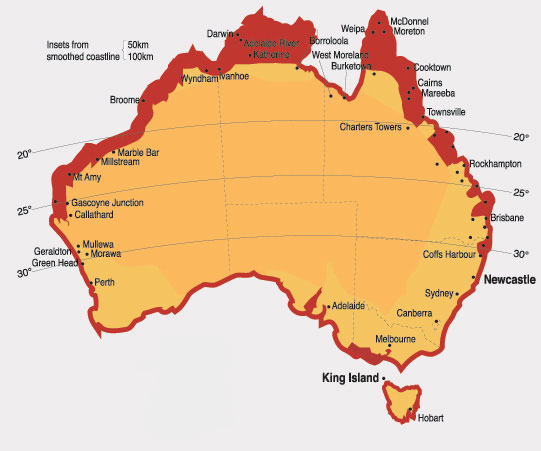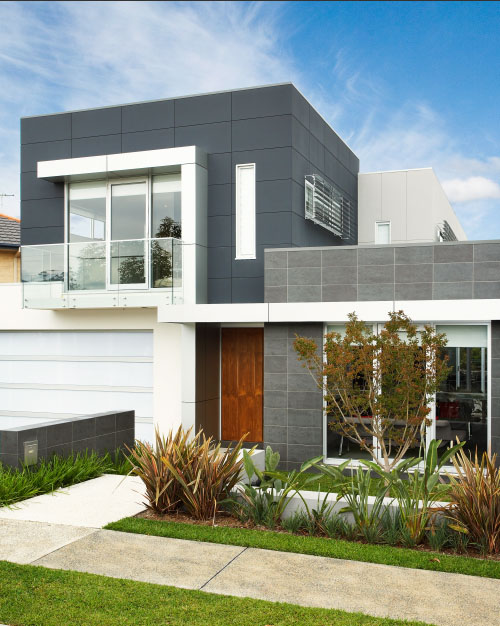A Nation on the Coast and the need for Sustainable Design
The appeal of sun, sand and surf has meant that now over 80% of Australians are living within the ‘coastal zones’ of our country.
We appreciate the lure: we are one of those 80% too.

However, we are often asked by clients what it is they need to consider when designing a beautiful coastal home, especially one that is intended to be enjoyed for years to come. With this in mind, we thought we would examine some important design and construction considerations, as well as materials that will ensure that the homes we build today will last– a well designed home is a valuable asset. A well designed home that blends harmoniously into the landscape whilst integrating environmental considerations is an extremely valuable asset.
Wind
That beautiful coastal location with stunning rugged vistas can mean that your home has to deal with some extreme wind conditions. Furthermore that delightful seaside breeze also carries with it the added risk of salt corrosion.
All external surfaces including walls, windows, doors and roofing can take a hammering by the wind, therefore it is important when planning your home to closely consider your site location, the surrounding landscape, and how to best utilise them effectively. Are there any naturally formed wind breaks like other buildings or large trees that could offer protection? Can you create them? Can the home be angled slightly to deflect the brunt of the wind or can more appropriate facades and cladding be selected for the aspect most affected?
Corrosion
This is one of the most destructive natural elements when building by the seaside. Now whilst that sweet smelling and refreshing sea breeze can invigorate the body and mind, this reactive element can also quickly penetrate materials, corroding them, impacting everything from roofs to window frames, balustrades, and even internal steel structures.
The higher levels of salt and moisture will impact any metal components of your home. Consider how you might use stainless steel, even for the strap bracing within walls. Whilst this initial added expense will not be visible, at least seaside corrosion will not compromise the integrity of your dwelling. For stainless steel fixtures and fittings elsewhere, make sure to consider the grade and quality used. If your home is within 5km of the beach aim for a minimum Grade 3/6. In the long run it will be more than a worthy investment as your maintenance requirements will drop dramatically.
For less expensive corrosion considerations, think about regularly washing down your external facades to remove excess salt. From your tank water of course!

Another vulnerable item for salt corosion worth mentioning is external air conditioning units. Not surprisingly, salt corrosion can reduce the life span of an air conditioning unit from 10-15 years to just 3-5 years if it is left exposed to the elements.
Potentially an expensive replacement if not located and protected correctly.
Keeping the Weather Out: Flashing
Inexpensive and effective, flashing makes your beach home watertight by directing water flow away from vulnerable areas, such as the intersections and protrusions of the roof structure, windows, doors, and the foundation walls . It’s a time-tested technique, that besides being effective, has two other giant advantages: it’s simple and cheap. Correctly designed and constructed flashing is important to any home, but even more so in the coastal environment. Make sure to consider how this will impact your design decisions. But what about the cladding?
External Cladding in Coastal Areas
Within many coastal towns you will see a smorgasbord of homes clad in weatherboard and fibre cement materials.
There is a reason why this form of cladding is so easily associated with the coastal palette.
Fibre cement cladding is purposely made to withstand extreme weather conditions, not only is it water and termite resistant but it also does not easily burn, rot or warp making it a fairly attractive option. Plus, it no longer has the looks of the “fibre cement shacks” of bygone days.
James Hardie have a range of fibre cement cladding options that are not only extremely functional but pleasing to the eye as well. This form of cladding is a composite material consisting of sand, cement and cellulose fibres, and is currently one of the most energy efficient products on the market. Surprising for some, fibre-cement cladding actually requires less energy in assembly and construction than most other wall products apart from timber. It has a low energy consumption for transportation and installation, no pesticides are used during manufacturing, and all water and byproducts required are reused and recycled, making this an extremely environmentally friendly option.



Timber
We love timber. Not only is it visually appealing, it’s a renewable resource, it stores carbon dioxide, it has a low embodied energy, and has a natural resilience to high winds and extreme climates. On top of this, unlike masonry or other rigid cladding materials, timber has a higher strength to weight ratio allowing it to withstand far greater stresses and movement.
Modern applied finishes can offer a long lasting and attractive appearance, easily allowing for a change in color and appearance to keep up with changing styles, however we love timber (I think I may have mentioned that before)…..because it looks like timber!
Therefore a thorough application of natural oils or a clear water repellent preservative will greatly assist in maintaining your natural timber cladding in great condition. Whilst initially this may mean more frequent maintenance than that required with painted timber or other external cladding options, in the long term, the water repellent preservative compounds will accumulate on the timber surface extending the time between applications.
Many view hardwood timbers as being ideal for high strength, structural purposes like bearers, joists, lintels and roof beams, however due to their natural durability, they are also perfect considerations for external decking and cladding. As a result of their long “above ground life”, hardwoods are also highly recyclable. In Australia’s, we have some incredible indigenous hardwood species, such as Jarrah, Blackwood and Red Gum, much prized for recycled flooring, paneling, furniture and landscaping.
Paint
Standard paints do have the potential to rapidly deteriorate in the harsh seaside conditions, although paint will last longer if applied onto a fibre cement cladding than on timber. There are several brands who do advocate a paint specifically suitable for use in coastal areas.
Whilst at times a high quality paint product can add a slight cost onto your initial build budget, in the long run when considering financial and labour maintenance requirements for the lifespan of the home it is certainly an investment worth considering. Brands like Wattyl and Taubmans both offer a suitable product as do Dulux with their ‘Weathershield’ promise. Speak to your local painter or hardware store to discuss what paint is most suitable for your needs.

Taking the time to think carefully about the design, materials, and construction of a coastal home will ensure that what is built today will last well into the future–making sure your beautiful ocean view is built to last.

